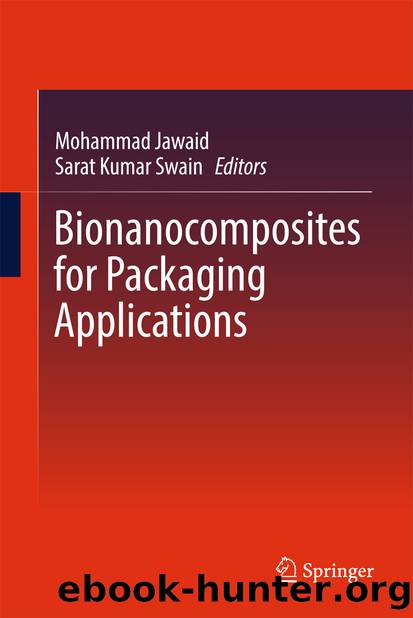Bionanocomposites for Packaging Applications by Mohammad Jawaid & Sarat Kumar Swain

Author:Mohammad Jawaid & Sarat Kumar Swain
Language: eng
Format: epub
Publisher: Springer International Publishing, Cham
7.5.2 Sugar Palm Starch Blend
Polymer blending is another type of polymer modification by combining two or more polymers in order to achieve the desired properties. Apart from using synthetic polymer, blending of starch with another biopolymer is a promising approach since the resulting materials will be able to sustain the biodegradable and renewable aspects of starch. Modification of thermoplastic sugar palm starch through incorporation with agar has been conducted in previous studies (Jumaidin et al. 2016, 2017). In this study, the sugar palm starch was pre-mixed with glycerol (30 wt% starch-based) in order to produce the thermoplasticity behavior of the material. The thermoplastic sugar palm starch was then incorporated with agar at 10 to 40 wt% by using internal mixer Brabender Plastograph at 140 °C for 10 min. Consequently, these mixtures were granulated and thermo-pressed at 140 °C for 10 min in order to obtain laminate plate with 3 mm thickness. In these processes, the presence of plasticizer and heat has transformed the starch and agar into thermoplastic polymer blend. The results show that incorporation of agar has increased the mechanical properties of the material, i.e., tensile, flexural, and impact strength. The authors attributed the properties enhancement of thermoplastic sugar palm starch/agar blend to several reasons. Firstly, chemical similarity between starch and agar has led to good miscibility and good phase compatibility between them. This finding was supported by the homogenous surface of the tensile fracture (Fig. 7.11). Furthermore, FTIR analysis indicates the formation of new hydrogen bonding between starch and agar following the blending process. Finally, the enhancement in the mechanical properties of thermoplastic sugar palm starch/agar blend was attributed to more entangled network structure of agar which provides strengthening effect to the polymer blend.
Fig. 7.11SEM micrograph of fracture surface of thermoplastic SPS blended with different ratio of agar a 0 wt% b 10 wt% c 20 wt% d 30 wt% e 40 wt% (Jumaidin et al. 2016)
Download
This site does not store any files on its server. We only index and link to content provided by other sites. Please contact the content providers to delete copyright contents if any and email us, we'll remove relevant links or contents immediately.
| Automotive | Engineering |
| Transportation |
Whiskies Galore by Ian Buxton(41530)
Introduction to Aircraft Design (Cambridge Aerospace Series) by John P. Fielding(32888)
Small Unmanned Fixed-wing Aircraft Design by Andrew J. Keane Andras Sobester James P. Scanlan & András Sóbester & James P. Scanlan(32573)
Craft Beer for the Homebrewer by Michael Agnew(17933)
Turbulence by E. J. Noyes(7700)
The Complete Stick Figure Physics Tutorials by Allen Sarah(7141)
Kaplan MCAT General Chemistry Review by Kaplan(6595)
The Thirst by Nesbo Jo(6437)
Bad Blood by John Carreyrou(6275)
Modelling of Convective Heat and Mass Transfer in Rotating Flows by Igor V. Shevchuk(6223)
Learning SQL by Alan Beaulieu(6035)
Weapons of Math Destruction by Cathy O'Neil(5829)
Man-made Catastrophes and Risk Information Concealment by Dmitry Chernov & Didier Sornette(5647)
Digital Minimalism by Cal Newport;(5389)
Life 3.0: Being Human in the Age of Artificial Intelligence by Tegmark Max(5184)
iGen by Jean M. Twenge(5161)
Secrets of Antigravity Propulsion: Tesla, UFOs, and Classified Aerospace Technology by Ph.D. Paul A. Laviolette(4992)
Design of Trajectory Optimization Approach for Space Maneuver Vehicle Skip Entry Problems by Runqi Chai & Al Savvaris & Antonios Tsourdos & Senchun Chai(4840)
Electronic Devices & Circuits by Jacob Millman & Christos C. Halkias(4748)
